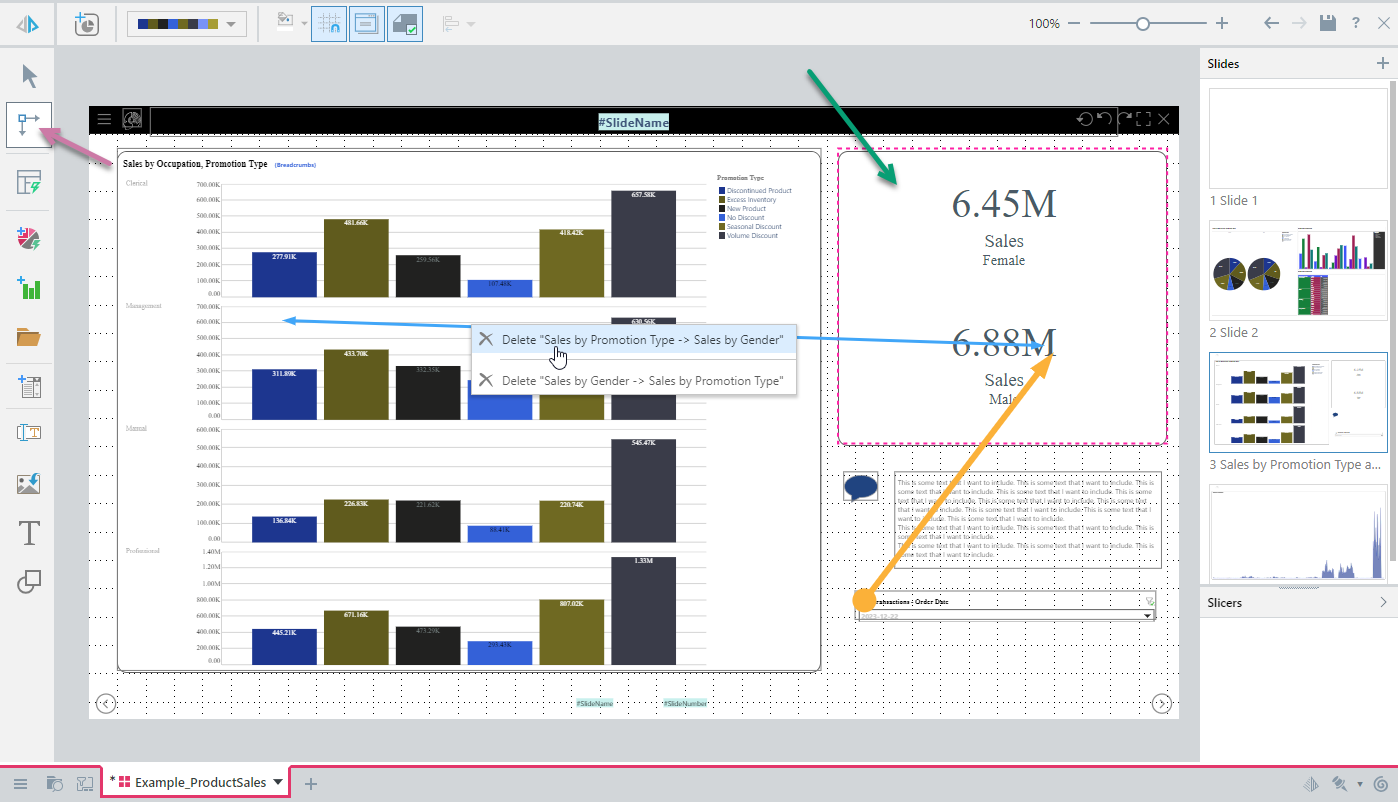When your user selects values from a slicer or elements in a visual at runtime, other visuals are typically highlighted or cross-filtered in response to that selection. For example, selecting Australia from a countries slicer may filter a Sales visual so that it only shows Australian sales. This functionality is enabled using interactions; connections between the items on a slide that define which items affect which other items. By default, interactions are automatically and invisibly created as you add relevant content items to your canvas, but you can use the Interaction Picker to show the existing interactions, and to delete existing interactions or add new interactions as needed.
As an example, you might want to remove interactions to simplify a slide in your presentation. If you have some metrics for male and female sales figures, say, you might always want to show the "headline" version of those figures for all sales globally. If that is the case, you can delete the interaction between any visuals or slicers and the metric on the slide. If you regret this change later, it is not a problem, you can add the interaction back in following the steps in this topic.
- Click here to learn more about the runtime effects of interactions
Interaction picker

Show interactions
From the Toolbox:
- Click Interaction Picker (purple arrow, above).
- Click any content item on the canvas to display its interactions (green arrow).
Your cursor transforms into an interaction selector.
The selected item is highlighted. The interactions both to and from the selected item are shown as single or double-headed arrows.
If you are happy with your interactions, you can click the Interaction Picker again to hide them.
About interaction arrows
When interactions are shown, they appear as arrows between content items on the slide. These arrows may be bidirectional (double-headed) for visuals, indicating that you can select either visual to filter the other; or they may by unidirectional (single-headed) typically for slicers, cascading slicers, or dynamic assets, with one of the content items filtering the other but no reverse interaction.
Interaction colors indicate the type of content interaction they represent:
- Cross-visual interactions and cross-slicer highlighting interactions are blue.
- Slicer interactions, Target interactions, and interactions with Dynamic Assets (such as dynamic text) are orange.
- Cross-slicer data interactions are green.
Delete Interactions
When you delete an interaction, selecting the source content item at runtime will no longer cause the target content item to be highlighted or filtered. You may choose to do this to limit unnecessary interactivity, making your slide simpler for your viewer.
With interactions showing on the canvas:
- Right-click the interaction that you want to delete.
- Do one of the following:
- If your interaction only flows in one direction (for example, it connects a slicer to a visual), select Delete Interaction.
- If your interaction flows in both directions (for example, it is a cross-visual interaction that links two visuals), select Delete <Item 1> -> <Item 2> or Delete <Item 2> -> <Item 1> as needed.
The interaction or interactions are removed from the canvas.
- Save your changes.
The interaction context menu opens.
Add Interactions
When you add an interaction to your slide, you are indicating that you want runtime viewers to be able to select a slicer or visual and for that to cause another visual to be highlighted or filtered in response.
From the Toolbox:
- Click Interaction Picker (purple arrow, above).
- Click the slicer or visual that you want to act as the source of your interaction and drag your cursor to the target. A green connector appears between the two objects; when you drop the connector the interaction is created.
Your cursor transforms into an interaction selector.
Cross-Model Interactions
Cross-model interactions connect content items from different data sources. This type of interaction is only supported "out-of-the-box" between models with the same structure. If you add interactions between items whose models have different structures (for example, different data types, formatting, hierarchies, and so on), the interactions will fail unless a Model Mapping is defined that maps the items in one model to items in the other.
Note: Cross-model mapping is an advanced feature and is not supported in Present Lite. If you need to create a cross-model mapping, you can only do so using Present Pro. For more information, see Model Mapping in Present Pro.